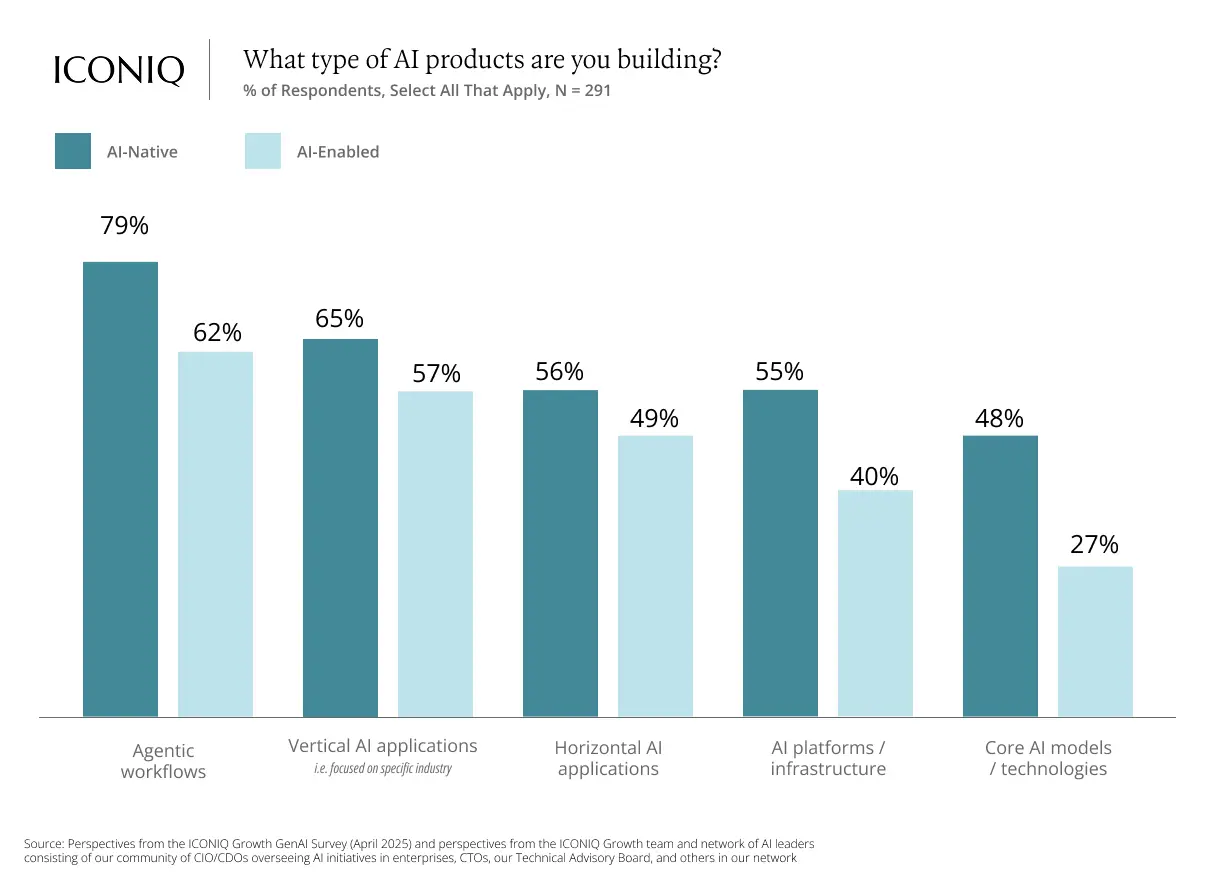Author: ICONIQ
Compiled by: Tim, PANews
The development of artificial intelligence has entered a new chapter: moving from a hot topic to practical implementation. Building scalable AI products is becoming a key battleground for competition. The 2025 AI Status Report "Builder's Handbook" shifts the focus from technology adoption to practical implementation, providing an in-depth analysis of the complete solution for conceptualizing, implementing, and scaling AI products.
Based on exclusive survey results from April 2025 involving 300 executives from software companies, combined with in-depth interviews with AI leaders within the ICONIQ community, this report offers a tactical roadmap aimed at transforming the intelligent advantages of generative AI into sustainable business competitiveness.
The report distills five key chapters and how they will assist teams in actively building AI applications.
1. AI Product Strategy Has Entered a New Stage of Maturity
Compared to companies that only integrate AI into existing products, AI-native companies are pushing products to market faster. Data shows that nearly half (47%) of AI-native enterprises have reached critical scale and have been validated for market fit, while only 13% of companies with integrated AI products have reached this stage.
What they are doing: Intelligent agent workflows and vertical applications are becoming mainstream. Nearly 80% of AI-native developers are laying out intelligent agent workflows (i.e., AI systems that can autonomously execute multi-step operations on behalf of users).
How they are doing it: Companies are converging on multi-model architectures to optimize performance, control costs, and match specific application scenarios. In customer-facing products, each respondent uses an average of 2.8 models.

2. Evolving AI Pricing Models Reflect Unique Economic Characteristics
Artificial intelligence is changing the way companies price their products and services. According to our survey, many companies are adopting hybrid pricing models, adding usage-based billing on top of a base subscription fee. Some companies are also exploring pricing models based entirely on actual usage or customer outcomes.
Currently, many companies still offer AI features for free, but over one-third (37%) of enterprises plan to adjust their pricing strategies in the coming year to better align prices with the value customers receive and their usage of AI features.

3. Talent Strategy as a Differentiation Advantage
Artificial intelligence is not just a technical issue; it is also an organizational issue. Currently, most top teams are forming cross-functional teams composed of AI engineers, machine learning engineers, data scientists, and AI product managers.
Looking ahead, most companies expect that 20-30% of their engineering teams will focus on AI, with this proportion expected to reach as high as 37% in high-growth companies. However, survey results indicate that finding the right talent remains a bottleneck. Among all AI-specific positions, hiring AI and machine learning engineers takes the longest, with an average fill time exceeding 70 days.
There are differing opinions on hiring progress. While some recruiters believe progress is smooth, 54% of respondents indicate that progress is lagging, with the most common reason being a lack of qualified talent resources.

4. Surge in AI Budgets Reflected in Company Profit and Loss Statements
Companies adopting AI technologies are allocating 10%-20% of their R&D budgets to AI, and businesses across all revenue ranges are showing a continuous growth trend in 2025. This strategic shift increasingly highlights that AI technology has become a core driving force in product strategic planning.
As the scale of AI products expands, the cost structure often undergoes significant changes. In the early stages of product development, human resource costs are typically the largest expenditure item, including recruitment, training, and skill enhancement expenses. However, as products mature, cloud service costs, model inference costs, and compliance regulatory costs will account for a major portion of expenditures.

5. The Scale of Internal AI Applications in Enterprises is Expanding, but Distribution is Uneven
Although most surveyed companies provide access to internal AI tools for about 70% of employees, only about half of them actually use these tools regularly. In larger, more mature organizations, the challenge of encouraging employees to use AI is particularly pronounced.
High adoption rate companies (where more than half of employees use AI tools) have deployed AI in an average of seven or more internal application scenarios, including programming assistants (77% usage), content generation (65%), and document search (57%). The efficiency gains in these areas range from 15% to 30%.

The AI Tools Ecosystem is Still Dispersed but Gradually Maturing
We surveyed hundreds of companies to understand the current technological frameworks, libraries, and platforms actually running in production environments. This report is not a simple ranking but a true reflection of the tools adopted by developers across different fields.
Below is a brief overview of the most commonly used tools, listed in alphabetical order:

免责声明:本文章仅代表作者个人观点,不代表本平台的立场和观点。本文章仅供信息分享,不构成对任何人的任何投资建议。用户与作者之间的任何争议,与本平台无关。如网页中刊载的文章或图片涉及侵权,请提供相关的权利证明和身份证明发送邮件到support@aicoin.com,本平台相关工作人员将会进行核查。




